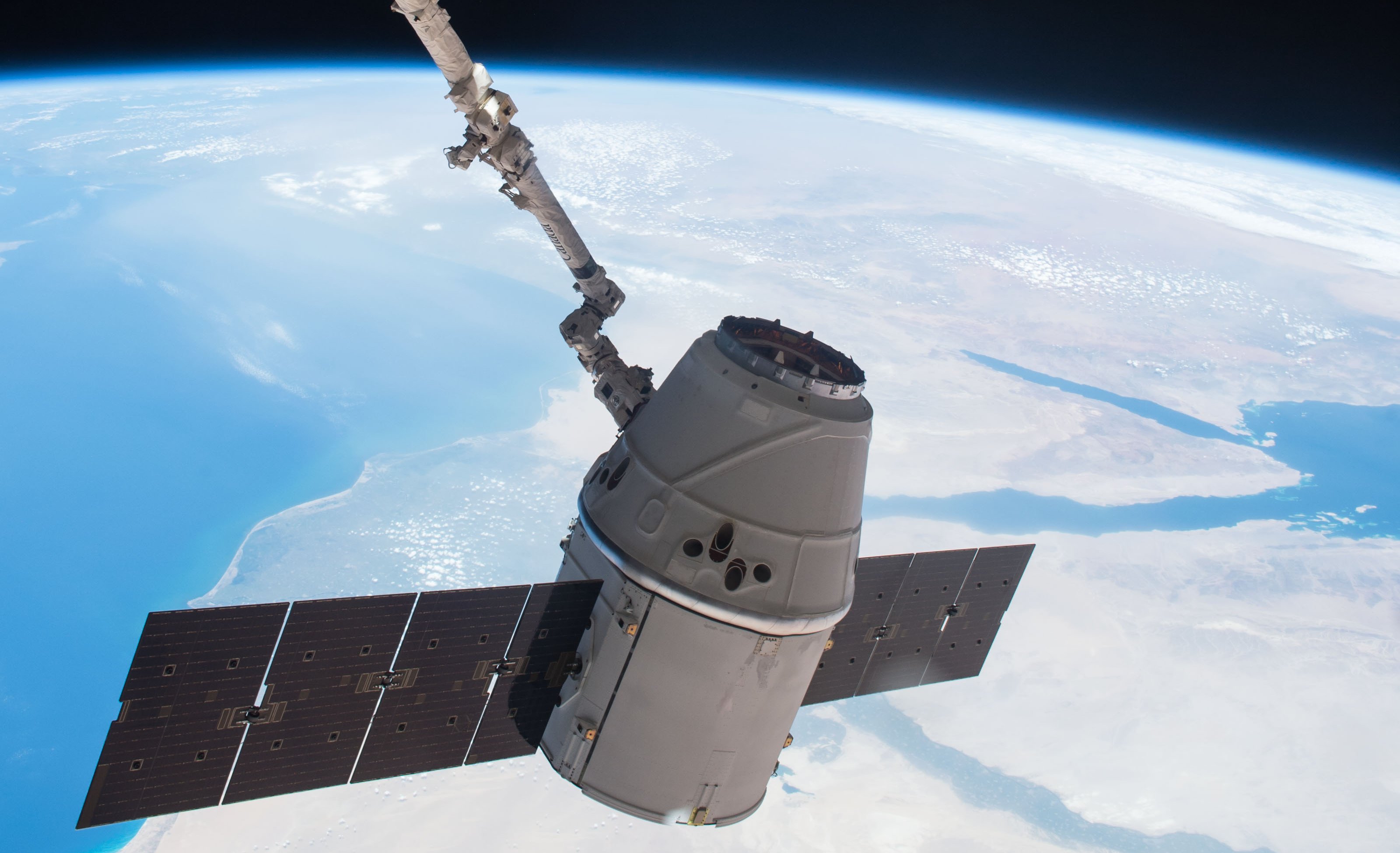
DIVIETI PAJEVIC LAB
Boston University ⁄ School of Dental Medicine
Molecular and Cell Biology
home
PAGE TOP
News
 In May 2015, the SpaceX Dragon spacecraft splashed down in the Pacific, the last stage of its sixth mission to the International Space Station. Inside, it carried a briefcase-sized metallic container of bone cells that belong to Boston University researcher Paola Divieti Pajevic. The cells, which have experienced the extremely low levels of gravity on the space station, could contain clues about better ways to treat osteoporosis and other conditions that cause bone loss, and also ways to support astronauts on longer missions, such as a trip to Mars.
In May 2015, the SpaceX Dragon spacecraft splashed down in the Pacific, the last stage of its sixth mission to the International Space Station. Inside, it carried a briefcase-sized metallic container of bone cells that belong to Boston University researcher Paola Divieti Pajevic. The cells, which have experienced the extremely low levels of gravity on the space station, could contain clues about better ways to treat osteoporosis and other conditions that cause bone loss, and also ways to support astronauts on longer missions, such as a trip to Mars.
Read More (Link)
 SpaceX’s Dragon cargo spacecraft departed the International Space Station (ISS) at 7:04 a.m. EDT Thursday and successfully splashed down in the Pacific Ocean at 12:42 p.m. The Dragon Spacecraft returned to Earth with nearly 3,100 pounds (≈1,400 kg) of NASA cargo, including specimens from research on how spaceflight and microgravity affect bone health and the aging process.
SpaceX’s Dragon cargo spacecraft departed the International Space Station (ISS) at 7:04 a.m. EDT Thursday and successfully splashed down in the Pacific Ocean at 12:42 p.m. The Dragon Spacecraft returned to Earth with nearly 3,100 pounds (≈1,400 kg) of NASA cargo, including specimens from research on how spaceflight and microgravity affect bone health and the aging process.
Read More (Link)
 Understanding the effects of microgravity on osteocytes will be critical as astronauts plan for future missions that require longer exposure to microgravity, such as to deep space or Mars. The results derived from this study could also have implications for patients on Earth in the treatment of bone disorders related to disuse or immobilization, as well as metabolic diseases such as osteoporosis.
Understanding the effects of microgravity on osteocytes will be critical as astronauts plan for future missions that require longer exposure to microgravity, such as to deep space or Mars. The results derived from this study could also have implications for patients on Earth in the treatment of bone disorders related to disuse or immobilization, as well as metabolic diseases such as osteoporosis.
Read More (Link)
 The Expedition 43 crew aboard the International Space Station (ISS) kept busy last week working on a large variety of research and experiments, most of which focused on learning how to improve the health of those living both on and off the planet.
The Expedition 43 crew aboard the International Space Station (ISS) kept busy last week working on a large variety of research and experiments, most of which focused on learning how to improve the health of those living both on and off the planet.
Read More (Link)
 CAPE CANAVERAL, Fla — Until recently, Florida residents Sally and Don (their last names have been withheld to protect their identity) have been quite ambivalent about space exploration. The launches at NASA’s Kennedy Space Center take place a mere 70 miles away from their home, but did not pay them much mind. That changed on April 14, however. On that day, NASA and SpaceX successfully began the Commercial Resupply Services (CRS-6 or SpX-6) mission. The Falcon 9 v1.1 booster and Dragon spacecraft roared into the afternoon sky on a trip to the International Space Station (ISS) orbiting some 220 miles above Earth. What captured their interest was one of the experiments included in the mission’s 4,900 lbs (2,223 kg) worth of payload, one aimed at discovering new treatments for osteoporosis.
CAPE CANAVERAL, Fla — Until recently, Florida residents Sally and Don (their last names have been withheld to protect their identity) have been quite ambivalent about space exploration. The launches at NASA’s Kennedy Space Center take place a mere 70 miles away from their home, but did not pay them much mind. That changed on April 14, however. On that day, NASA and SpaceX successfully began the Commercial Resupply Services (CRS-6 or SpX-6) mission. The Falcon 9 v1.1 booster and Dragon spacecraft roared into the afternoon sky on a trip to the International Space Station (ISS) orbiting some 220 miles above Earth. What captured their interest was one of the experiments included in the mission’s 4,900 lbs (2,223 kg) worth of payload, one aimed at discovering new treatments for osteoporosis.
Read More (Link)
NASA Commentator Dan Huot talks with Dr. Paola Divieti Pajevic, the principal investigator of the Osteo-4 experiment which is arriving at the International Space Station on the new Dragon cargo ship, about her research into the function of osteocytes, the cells in the bones which sense mechanical forces. The experiment will study the function and behavior of those cells in space to try to determine why astronauts who spend long periods in space lose bone density; the findings may have also applications for people on Earth who suffer bone disorders.
Sunday, April 12 (L-1 day): An ISS Science, Research and Technology briefing was held at Kennedy's Press Site at 1:30 p.m. and featured engineer and science participants. Science payloads will study new ways to possibly counteract the microgravity-induced cell damage seen during spaceflight, the effects of microgravity on the most common cells in bones, gather new insight that could lead to treatments for osteoporosis and muscle wasting conditions, continue studies into astronaut vision changes and test a new material that could one day be used as a synthetic muscle for robotics explorers of the future.
 Researchers may be “excyted” to learn that osteocyte cultures are headed to the International Space Station this spring for the first time. With their delivery on the next SpaceX commercial resupply services mission this month, the Osteocytes and mechano-transduction (Osteo-4) investigation team will analyze the effects of microgravity on this type of bone cell. Understanding these effects will be critical as astronauts plan for future missions that require longer exposure to microgravity, such as to deep space or Mars. The results derived from this study could also have implications for patients on Earth in the treatment of bone disorders related to disuse or immobilization, as well as metabolic diseases such as osteoporosis.
Researchers may be “excyted” to learn that osteocyte cultures are headed to the International Space Station this spring for the first time. With their delivery on the next SpaceX commercial resupply services mission this month, the Osteocytes and mechano-transduction (Osteo-4) investigation team will analyze the effects of microgravity on this type of bone cell. Understanding these effects will be critical as astronauts plan for future missions that require longer exposure to microgravity, such as to deep space or Mars. The results derived from this study could also have implications for patients on Earth in the treatment of bone disorders related to disuse or immobilization, as well as metabolic diseases such as osteoporosis.
Read More (Link)
 On the floor of Paola Divieti Pajevic's officeat Massachusetts General Hospital sits a large silvery suitcase that holds precious cargo: a set of minimalist equipment and electronics for conducting a cell biology experiment in space. Sometime in 2014, this payload will journey more than 200 miles above the earth to the International Space Station, or ISS. Inside the case, cells will grow on scaffolds in several cylinders called bioreactors.
On the floor of Paola Divieti Pajevic's officeat Massachusetts General Hospital sits a large silvery suitcase that holds precious cargo: a set of minimalist equipment and electronics for conducting a cell biology experiment in space. Sometime in 2014, this payload will journey more than 200 miles above the earth to the International Space Station, or ISS. Inside the case, cells will grow on scaffolds in several cylinders called bioreactors.
Read More (Link)
 The National Institutes of Health (NIH) Biomedical Research on the International Space Station (BioMed-ISS) is funding three proposals for space station research. Dr. Divieti Pajevic, an Assistant Professor of Medicine at Harvard Medical School and a member of the Endocrine Unit at Massachusetts General Hospital in Boston, is the lead for one of the winning proposals. Her investigation will use microgravity to study bone density loss, whether from disuse or disease. The NIH selected the final proposals because of their value in using space to make discoveries that can improve human health on Earth.
The National Institutes of Health (NIH) Biomedical Research on the International Space Station (BioMed-ISS) is funding three proposals for space station research. Dr. Divieti Pajevic, an Assistant Professor of Medicine at Harvard Medical School and a member of the Endocrine Unit at Massachusetts General Hospital in Boston, is the lead for one of the winning proposals. Her investigation will use microgravity to study bone density loss, whether from disuse or disease. The NIH selected the final proposals because of their value in using space to make discoveries that can improve human health on Earth.
Read More (Link)
Copyright ©2025 Divieti Pajevic Lab. All rights reserved. Site designed by YUHEI.
 In May 2015, the SpaceX Dragon spacecraft splashed down in the Pacific, the last stage of its sixth mission to the International Space Station. Inside, it carried a briefcase-sized metallic container of bone cells that belong to Boston University researcher Paola Divieti Pajevic. The cells, which have experienced the extremely low levels of gravity on the space station, could contain clues about better ways to treat osteoporosis and other conditions that cause bone loss, and also ways to support astronauts on longer missions, such as a trip to Mars.
In May 2015, the SpaceX Dragon spacecraft splashed down in the Pacific, the last stage of its sixth mission to the International Space Station. Inside, it carried a briefcase-sized metallic container of bone cells that belong to Boston University researcher Paola Divieti Pajevic. The cells, which have experienced the extremely low levels of gravity on the space station, could contain clues about better ways to treat osteoporosis and other conditions that cause bone loss, and also ways to support astronauts on longer missions, such as a trip to Mars.

